Veradigm Bundle
Who are Veradigm's Key Customers?
In the ever-evolving healthcare landscape, understanding Veradigm SWOT Analysis is crucial for strategic success. As a leading provider of healthcare technology solutions, Veradigm's ability to adapt to changing regulations and technological advancements is paramount. This exploration delves into the vital importance of customer demographics and target market analysis for Veradigm company.
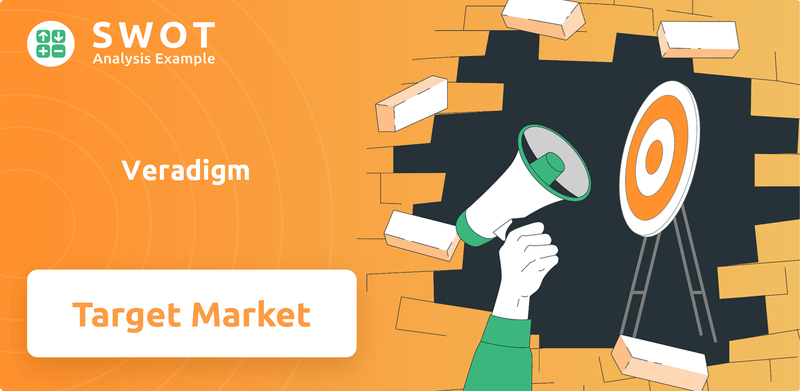
Veradigm's journey, from its origins within Allscripts to its current independent status, underscores the significance of pinpointing its Veradigm target market. The company's shift from practice-centric solutions to a broader data and analytics approach reflects a strategic response to the needs of its diverse customer base. Analyzing Veradigm customer profile analysis and Veradigm ideal customer characteristics is essential for navigating the complexities of healthcare data analytics and capitalizing on emerging opportunities within the patient population.
Who Are Veradigm’s Main Customers?
The primary customer segments for the company operate within a Business-to-Business (B2B) model, focusing on the healthcare sector. The company's target market includes a diverse range of healthcare stakeholders. Key customer groups include healthcare providers, payers, and life sciences companies.
Within healthcare providers, the company targets physician practices, hospitals, and integrated delivery networks (IDNs). These range from small independent clinics to large multi-specialty groups and health systems. Payers, such as health insurance companies, also form a significant customer segment. Life sciences companies, including pharmaceutical and biotechnology firms, represent a growing area of focus.
These segments leverage the company's solutions for various purposes. Healthcare providers use electronic health records (EHR) systems, practice management solutions, and data analytics. Payers utilize data and analytics for population health management and claims processing. Life sciences companies rely on de-identified patient data for research, development, and commercialization strategies. Understanding the Veradigm target market is crucial for strategic planning and market positioning.
This segment includes physician practices, hospitals, and IDNs. They use the company's solutions to enhance clinical outcomes and financial performance. Factors like practice size, specialty, and organizational structure are key considerations when analyzing this Veradigm customer profile analysis.
Payers, such as health insurance companies, utilize the company's data and analytics. They focus on managing population health, improving care coordination, and optimizing claims processing. Their covered lives and geographical reach are important criteria.
Pharmaceutical and biotechnology firms represent a growing segment. They rely on de-identified patient data for research and development. They also use it for real-world evidence generation and commercialization strategies. Their research focus and market presence are key.
The life sciences and payer segments are experiencing significant growth. This shift is driven by the digitalization of healthcare and the emphasis on data-driven insights. The company has expanded its data analytics and research solutions to meet these evolving demands. The company's customer demographics are influenced by these trends.
While traditional demographics like age and income are less relevant, other factors are crucial for understanding the company's customer base. The company's approach involves a deep understanding of each segment's specific needs and challenges. This market segmentation strategy allows for tailored solutions and effective customer relationship management.
- Practice size and specialty for healthcare providers.
- Covered lives and geographical reach for payers.
- Research focus and market presence for life sciences companies.
- The company's customer acquisition strategy is tailored to these segments.
Veradigm SWOT Analysis
- Complete SWOT Breakdown
- Fully Customizable
- Editable in Excel & Word
- Professional Formatting
- Investor-Ready Format
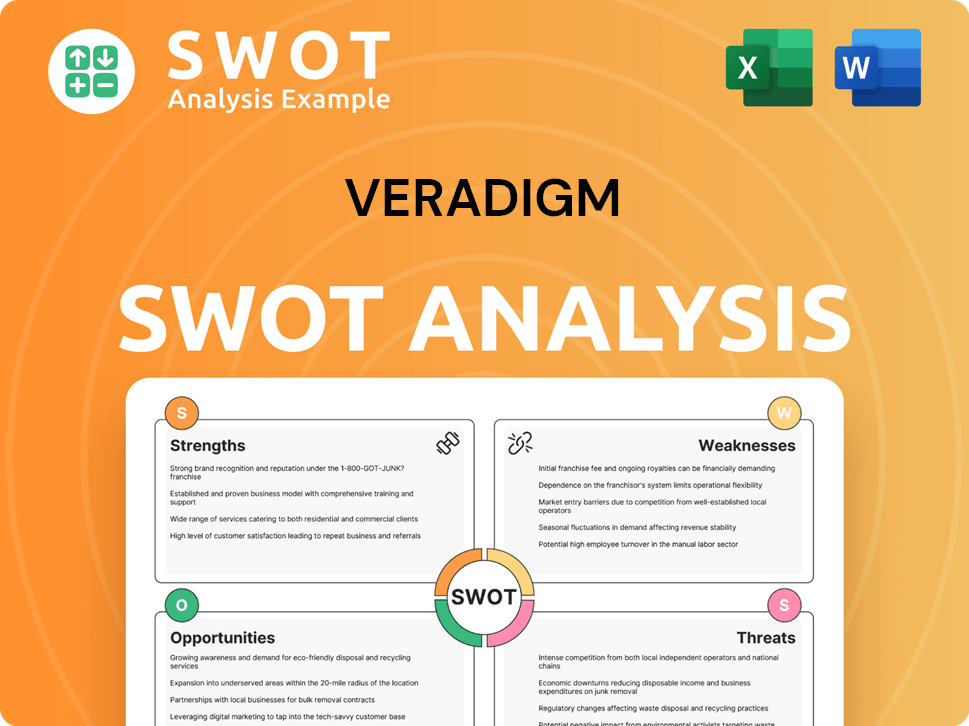
What Do Veradigm’s Customers Want?
Understanding the customer needs and preferences is crucial for the success of any business, and for the healthcare technology company, it's no different. The customer demographics of the company are varied, including healthcare providers, payers, and life sciences companies, each with unique requirements. The company's success hinges on its ability to meet these diverse needs effectively.
The company's target market is driven by the pursuit of improved patient outcomes, enhanced operational efficiency, and robust financial performance. Healthcare providers seek integrated solutions that streamline clinical workflows and reduce administrative burdens. Payers focus on managing healthcare costs and ensuring regulatory compliance. Life sciences companies are driven by the need to accelerate drug discovery and development.
The company addresses common pain points such as data silos, regulatory complexities, and the challenge of extracting actionable insights from healthcare data. By understanding these needs and preferences, the company can tailor its products and services to meet the specific demands of each customer segment, ensuring customer satisfaction and driving business growth. For a deeper dive into the company's origins and evolution, consider reading the Brief History of Veradigm.
The company's customer base is segmented based on the specific needs and priorities of each group. Healthcare providers prioritize interoperability, ease of use, and compliance with regulations. Payers focus on data accuracy and analytical capabilities to manage costs. Life sciences companies require comprehensive, de-identified data for research.
- Healthcare Providers: They prioritize EHR systems with robust clinical decision support and patient engagement tools. The market for EHR systems is substantial, with projections indicating continued growth. For example, the global EHR market was valued at approximately $30.7 billion in 2023 and is expected to reach $43.5 billion by 2028, growing at a CAGR of 7.2% from 2023 to 2028.
- Payers: They seek data analytics solutions that provide insights into patient populations and care utilization. The healthcare analytics market is also experiencing significant expansion. The global healthcare analytics market was estimated at $37.8 billion in 2023 and is projected to reach $98.9 billion by 2028, growing at a CAGR of 21.2% from 2023 to 2028.
- Life Sciences Companies: They require access to large, de-identified patient data sets for research. The real-world data (RWD) market, which is essential for life sciences, is also growing rapidly. The global RWD market in healthcare was valued at $29.5 billion in 2023 and is expected to reach $72.4 billion by 2028, with a CAGR of 19.6% from 2023 to 2028.
- Data Privacy and Compliance: The company must adhere to strict data privacy regulations such as HIPAA, which is critical for maintaining customer trust and ensuring legal compliance.
Veradigm PESTLE Analysis
- Covers All 6 PESTLE Categories
- No Research Needed – Save Hours of Work
- Built by Experts, Trusted by Consultants
- Instant Download, Ready to Use
- 100% Editable, Fully Customizable
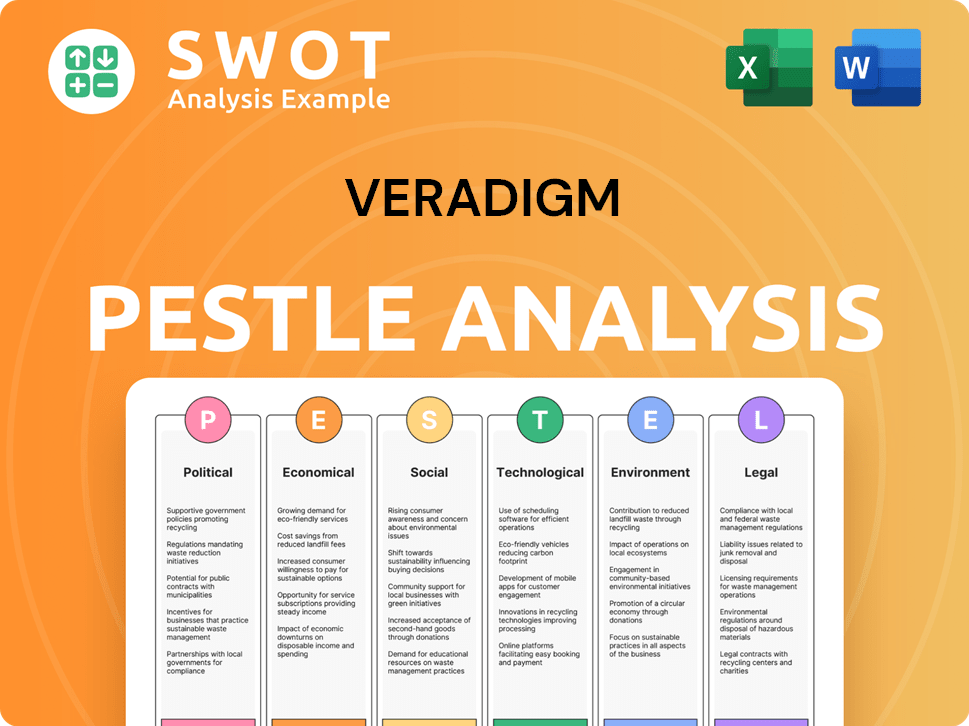
Where does Veradigm operate?
The geographical market presence of the company is predominantly within the United States. The company serves a wide array of healthcare providers, payers, and life sciences companies across the nation. The company's market share and brand recognition are notably strong, especially within the ambulatory physician practice segment, thanks to its longstanding presence in the EHR market.
While specific major markets by city aren't typically disclosed, the company's solutions are utilized throughout all U.S. regions, reflecting the widespread demand for healthcare technology and data analytics. This widespread adoption underscores the importance of understanding the company's customer demographics and how it tailors its offerings to meet diverse regional needs.
The company's focus on the U.S. market is evident in its strategic adjustments, particularly in expanding its data and analytics services. This expansion includes targeting new segments like life sciences, which have less geographical constraints in their data needs. The geographic distribution of sales and growth largely mirrors the distribution of healthcare expenditures and the adoption rate of healthcare technology within the U.S.
The company's primary market is the United States, with a strong presence across all regions. This nationwide reach reflects the broad need for healthcare technology and data analytics solutions. The company's success is tied to its ability to serve a diverse customer base within the U.S. healthcare landscape.
Differences in customer demographics and preferences across U.S. regions are influenced by healthcare regulations and delivery models. For example, states with integrated health systems may have different needs compared to those dominated by independent practices. Understanding these regional nuances is crucial for effective market segmentation.
While the U.S. is the main focus, the company has also engaged in international activities, although to a lesser extent than its domestic operations. This suggests a strategic prioritization of the U.S. market. International expansion could represent future growth opportunities.
The company localizes its offerings by adhering to state-level regulations and addressing regional healthcare challenges. This approach ensures relevance and competitiveness in diverse markets. This strategy helps the company maintain its position in the competitive landscape market.
The company's geographic focus is a key aspect of its business strategy. The company's ability to adapt to regional differences in healthcare regulations and delivery models is crucial for maintaining its market position. For more insights into the company's financial performance and business model, consider reading the article Revenue Streams & Business Model of Veradigm.
Veradigm Business Model Canvas
- Complete 9-Block Business Model Canvas
- Effortlessly Communicate Your Business Strategy
- Investor-Ready BMC Format
- 100% Editable and Customizable
- Clear and Structured Layout
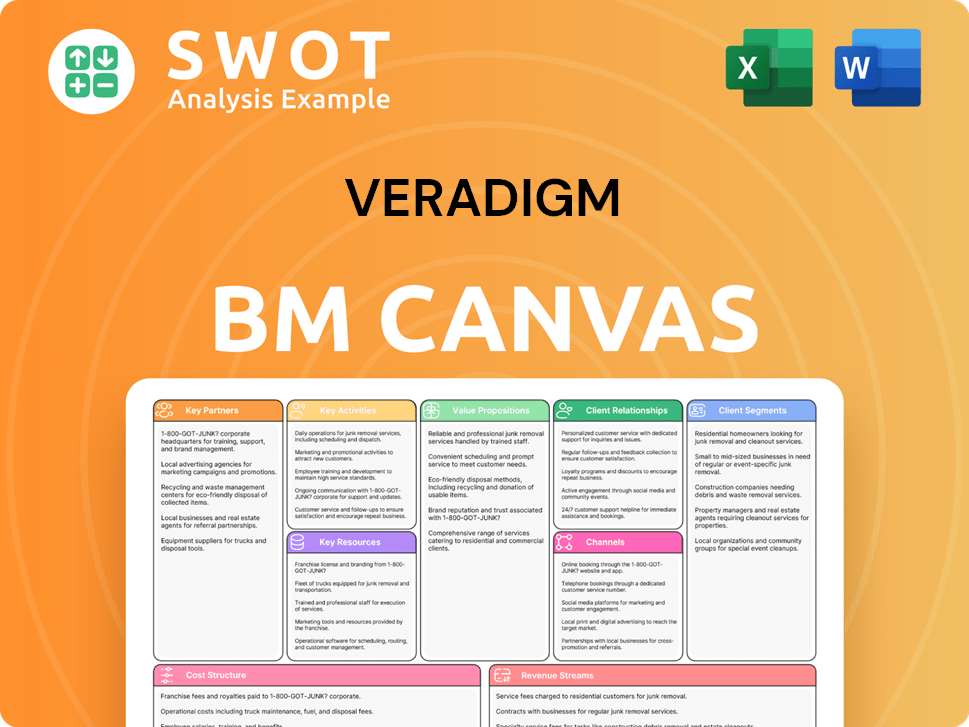
How Does Veradigm Win & Keep Customers?
The company employs a multi-faceted strategy for acquiring and retaining customers. This approach combines digital marketing, traditional methods, and a direct sales force. The goal is to reach a wide range of clients and build lasting relationships within the healthcare industry.
Digital marketing, including search engine optimization (SEO) and targeted online advertising, plays a key role in customer acquisition. Traditional methods, such as attending healthcare technology conferences, are also important. A robust direct sales team engages with healthcare organizations, payers, and life sciences companies to showcase solutions.
Customer retention strategies focus on delivering value, providing excellent service, and fostering long-term partnerships. This includes dedicated account management, regular software updates, and comprehensive training. Data and CRM systems are used to understand customer needs and personalize interactions, helping to identify and address potential issues.
The company uses a mix of digital marketing, traditional marketing, and direct sales. Digital marketing includes SEO, content marketing, and targeted online advertising. Traditional marketing involves participation in healthcare conferences. The direct sales force engages with potential clients directly.
Retention efforts focus on delivering high-value solutions and providing excellent customer service. This includes dedicated account management, regular software updates, and comprehensive training. Customer data and CRM systems are used to personalize interactions and address potential churn risks.
Digital marketing includes SEO to improve search engine rankings. Content marketing, such as whitepapers, is used to educate and attract potential customers. Targeted online advertising on healthcare industry platforms is also employed to reach specific audiences.
The direct sales team engages with healthcare organizations, payers, and life sciences companies. This includes personalized outreach and solution demonstrations. The focus is on building relationships and showcasing the value of the solutions offered.
The company aims to build lasting relationships through its customer acquisition and retention strategies. By focusing on value delivery and customer service, the company strives to become an indispensable partner for its clients. For further insights, consider reading about the Growth Strategy of Veradigm.
The company uses customer data and CRM systems to understand customer needs. This data-driven approach helps personalize marketing and support initiatives. It allows for proactive identification of potential churn risks.
Successful acquisition campaigns highlight the benefits of the solutions. These include improved revenue cycle management for providers. They also include accelerated research timelines for life sciences companies.
Innovative retention initiatives include user communities and forums. Clients can share best practices and provide feedback. This fosters a sense of partnership and continuous improvement.
The company has shifted to emphasize data-driven insights and integrated solutions. This is in response to customers seeking comprehensive platforms. This strategic shift has positively impacted customer loyalty.
The company segments its customer base to understand specific needs. This allows for tailored marketing campaigns and support initiatives. This targeted approach enhances customer satisfaction.
The company focuses on fostering long-term partnerships with its clients. This includes providing exceptional customer service and support. This approach increases customer lifetime value.
Veradigm Porter's Five Forces Analysis
- Covers All 5 Competitive Forces in Detail
- Structured for Consultants, Students, and Founders
- 100% Editable in Microsoft Word & Excel
- Instant Digital Download – Use Immediately
- Compatible with Mac & PC – Fully Unlocked
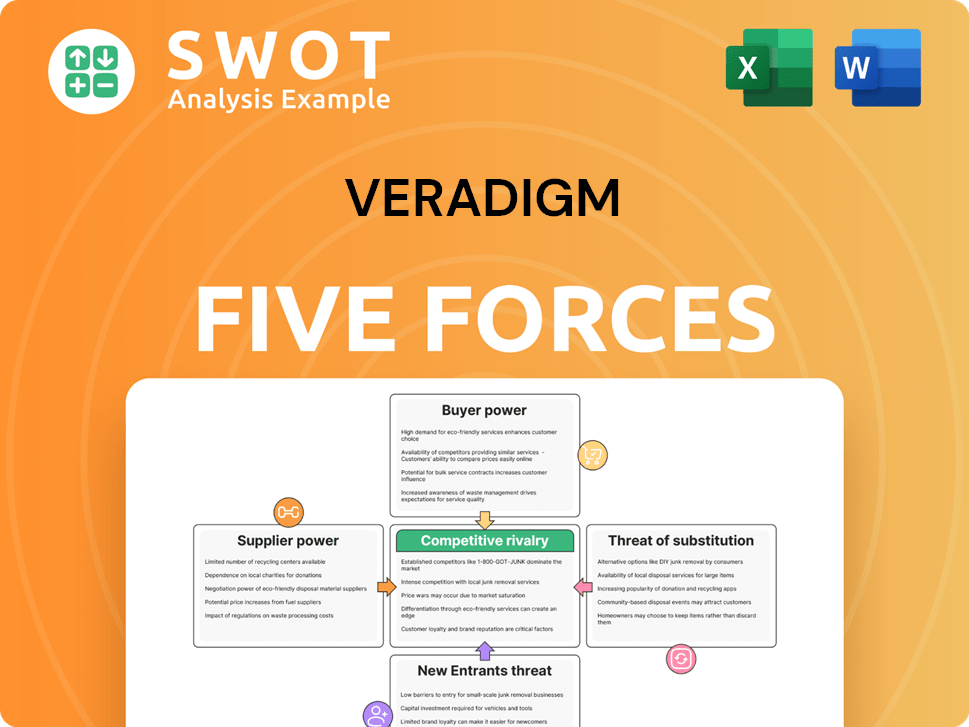
Related Blogs
- What are Mission Vision & Core Values of Veradigm Company?
- What is Competitive Landscape of Veradigm Company?
- What is Growth Strategy and Future Prospects of Veradigm Company?
- How Does Veradigm Company Work?
- What is Sales and Marketing Strategy of Veradigm Company?
- What is Brief History of Veradigm Company?
- Who Owns Veradigm Company?
Disclaimer
All information, articles, and product details provided on this website are for general informational and educational purposes only. We do not claim any ownership over, nor do we intend to infringe upon, any trademarks, copyrights, logos, brand names, or other intellectual property mentioned or depicted on this site. Such intellectual property remains the property of its respective owners, and any references here are made solely for identification or informational purposes, without implying any affiliation, endorsement, or partnership.
We make no representations or warranties, express or implied, regarding the accuracy, completeness, or suitability of any content or products presented. Nothing on this website should be construed as legal, tax, investment, financial, medical, or other professional advice. In addition, no part of this site—including articles or product references—constitutes a solicitation, recommendation, endorsement, advertisement, or offer to buy or sell any securities, franchises, or other financial instruments, particularly in jurisdictions where such activity would be unlawful.
All content is of a general nature and may not address the specific circumstances of any individual or entity. It is not a substitute for professional advice or services. Any actions you take based on the information provided here are strictly at your own risk. You accept full responsibility for any decisions or outcomes arising from your use of this website and agree to release us from any liability in connection with your use of, or reliance upon, the content or products found herein.